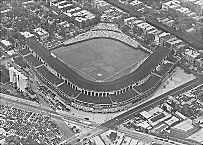| Entries |
| W |
|
Wrigley Field
|

|
Rich in legends, redolent with nostalgia, and superbly maintained, Wrigley Field is known nationwide as a site for baseball as it once was and as many would like it still to be: a game played on natural grass, chiefly in the daytime, in intimate surroundings that link players and fans, in a residential neighborhood rather than a sea of parking lots. Rumbling by the right-field stands, “ L ” trains link baseball with its yesterdays and the Cubs with their legions of North Side fans.
Successfully marketing “Beautiful Wrigley Field” and “The Friendly Confines” as an attractive place to spend a carefree afternoon in the sun, the Wrigleys and the Tribune Company (owners since 1981) have found it unnecessary in the modern era to mount a consistently good team. Built for baseball, the park proved an unsuitable home for football's Chicago Bears, who played there until 1970. At the beginning of the twenty-first century, about to become the oldest ballpark in baseball, Wrigley Field had become a model for a new generation of baseball-only parks in other cities.
The Encyclopedia of Chicago © 2004 The Newberry Library. All Rights Reserved. Portions are copyrighted by other institutions and individuals. Additional information on copyright and permissions.